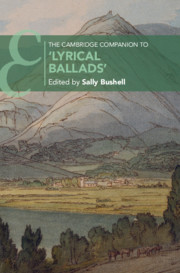Book contents
- The Cambridge Companion to ‘Lyrical Ballads’
- The Cambridge Companion to ‘Lyrical Ballads’
- Copyright page
- Dedication
- Contents
- Contributors
- Acknowledgements
- Chronology
- Abbreviations
- Introduction
- Part I Part and Whole
- Chapter 1 Wordsworth’s ‘Preface’: A Manifesto for British Romanticism
- Chapter 2 Collaboration, Domestic Co-Partnery and Lyrical Ballads
- Chapter 3 Coleridgean Contributions
- Chapter 4 Lyric Voice and Ballad Voice
- Part II Subjects and Situations from Common Life
- Part III Feeling and Thought
- Part IV Language and the Human Mind
- Part V A Global Lyrical Ballads
- Guide to Further Reading
- Index
Chapter 2 - Collaboration, Domestic Co-Partnery and Lyrical Ballads
from Part I - Part and Whole
Published online by Cambridge University Press: 08 February 2020
- The Cambridge Companion to ‘Lyrical Ballads’
- The Cambridge Companion to ‘Lyrical Ballads’
- Copyright page
- Dedication
- Contents
- Contributors
- Acknowledgements
- Chronology
- Abbreviations
- Introduction
- Part I Part and Whole
- Chapter 1 Wordsworth’s ‘Preface’: A Manifesto for British Romanticism
- Chapter 2 Collaboration, Domestic Co-Partnery and Lyrical Ballads
- Chapter 3 Coleridgean Contributions
- Chapter 4 Lyric Voice and Ballad Voice
- Part II Subjects and Situations from Common Life
- Part III Feeling and Thought
- Part IV Language and the Human Mind
- Part V A Global Lyrical Ballads
- Guide to Further Reading
- Index
Summary
Lyrical Ballads is well established as a work of literary collaboration, co-conceived, co-authored and ‘rooted in friendship’.1 Jack Stillinger calls it ‘the most famous co-authored book in English literature’.2 The ‘most famous’ literary collaborators are of course Samuel Taylor Coleridge and William Wordsworth, ‘twins almost in genius and mind’ as Wordsworth phrases it in his Prelude.3 However, the volume’s various, complex print histories point to the role of multiple collaborators in creating the texts we know as Lyrical Ballads. This chapter begins with a re-examination of the original project of creating an anonymous, collaborative poetry collection, taking into account the 1798 print variants, and moves towards a wider examination of what collaboration may mean in the production of the 1798 and 1800 editions. In so doing, it reconsiders the role of literary friendships and influences, as well as the domestic processes of poetic production. More importantly, this chapter re-centres Dorothy Wordsworth as a key collaborator, drawing on Elizabeth Fay’s conception of Wordsworth the poet as ‘William and Dorothy Wordsworth combined’.4 Nicola Healey calls Lyrical Ballads ‘a symbol of their collaborative textual union’.5 However, even in the introduction to the authoritative Cornell edition of Lyrical Ballads, Dorothy appears only as a companion, a copyist, and as a commentator on the publication prospects of the male poets’ work. This chapter therefore follows on from the work of Fay and Healey in repositioning Dorothy as a principal creative partner, as ‘part of William’s writing self’, as well as considering the importance of the presence of John Wordsworth at Dove Cottage during the production of the 1800 edition (Healey, 167).
- Type
- Chapter
- Information
- The Cambridge Companion to 'Lyrical Ballads' , pp. 32 - 48Publisher: Cambridge University PressPrint publication year: 2020



